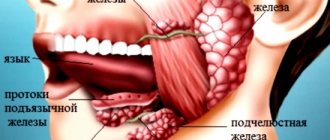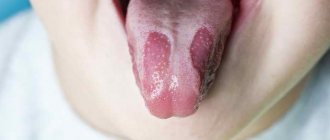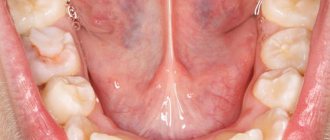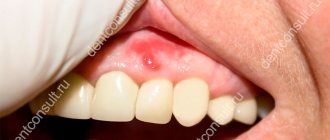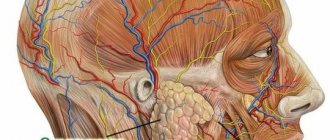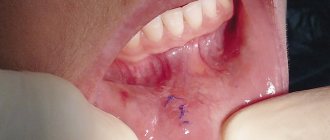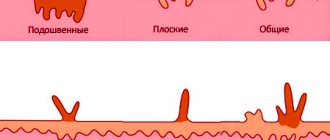Inflammation of the salivary glands is a dangerous condition that leads to indigestion, sudden weight loss and dehydration of the body. Dogs suffering from inflammatory processes become more lethargic and apathetic, they are prone to nervous disorders and aggressiveness. For information about what causes inflammation of the salivary glands and what symptoms indicate this, see below.
Read in this article
- What is this?
- Causes of diseases
- Symptoms of inflammation of the salivary glands
- Diagnosis and treatment
- Prevention
Types of salivary glands and their functions in the body
Salivary glands in cats are secretory structures of the anterior digestive tract. Located in the oral cavity and beyond. The main function is the production of saliva - a transparent, colorless liquid, which not only contributes to the process of eating food, but also protects the oral mucosa from drying out, mechanical, thermal, and chemical damage.
Types of salivary glands in cats:
- submandibular;
- sublingual;
- indigenous;
- infraorbital;
- zygomatic (orbital);
- parotid.
Important! The main major and minor salivary glands in cats are paired.
The main functions of the salivary glands in the animal body:
- Secretory. Production of a secretion that moisturizes the oral cavity. This is necessary for the two-way transport of chemicals between saliva and mucosa.
- Excretory, transport. The salivary glands take part in the transport of substances from the blood plasma into the secretion. Together with saliva, hormones (insulin, thyroxine, steroids) enter the oral cavity.
- Regulatory. The salivary glands have endocrine functions, stimulate protein synthesis, and promote the healing of mucosal damage.
Veterinary Service "Home Doctor"
At first glance, it seems that diseases of the salivary glands are rare in the practice of a veterinarian. And the owner, having discovered “some dense balls” in the area of the animal’s muzzle and neck, may first of all think about problems with the lymph nodes.
Salivary glands are abundant in the oral cavity of dogs and cats. The main salivary glands in both species are paired parotid, submandibular, sublingual and zygomatic (orbital). Cats also have a molar salivary gland. In dogs and cats, the sublingual gland is divided into two parts.
Causes of damage (etiology) of the salivary glands.
- Trauma – blunt or penetrating wounds. Iatrogenic injuries (received during the performance of any diagnostic procedures) are possible.
- Foreign bodies (accidentally eating sharp and hard blades of grass and leaves can lead to blockage of the ducts of the parotid salivary gland).
- Bacterial and viral infections (eg leukemia).
- Formation of calculi (stones) in the ducts of the salivary glands.
- Immune-mediated diseases.
- Neoplasia (tumors).
- Idiopathic (unknown) etiology.
Breed predisposition : in dogs - poodles, greyhounds, German shepherds, dachshunds, Australian silky terriers, boxers; in cats - uncharacteristic.
Age predisposition : mainly young animals are affected; tumors are more often found in older animals.
Attention!
If you notice any disturbances in your pet’s behavior during meals, as well as in its appetite, we recommend contacting a specialist without relying on your own abilities to treat a sick animal.
Major diseases of the salivary glands.
Sialadenitis is an inflammation of the salivary glands, mainly of a nonspecific nature (against the background of a systemic viral and bacterial infection, as well as with oral trauma or hematogenous diseases). Accompanied by swelling and pain in the affected area, especially with the mouth open, as well as suppuration. If left untreated, it often progresses to necrosis of the salivary gland.
Sialocele (mucocele) is a mucous cyst of the salivary gland, the most common disease in dogs, less often in cats. A cyst is formed in the subcutaneous or submucosal layer as a result of blockage of the outlet of the salivary gland and retention of its secretion.
Sialadenosis is an enlargement of the salivary glands of unknown etiology (cause) of a non-infectious nature (mainly in the submandibular and, rarely, zygomatic salivary glands). Often accompanied by neurological symptoms.
Sialolithiasis is a rare disease - the formation of calculi (stones) in the salivary gland with subsequent blockage of its duct. Usually the parotid glands are affected (in dogs), sometimes the submandibular and sublingual glands. The main treatment is surgical - removal of a calculus (sialolith) from the duct or excision of the gland duct.
Neoplasms of the salivary glands. In 30% of cases, these are malignant tumors (usually adenocarcinoma), which metastasize to the lymph nodes (buccal and mandibular) and to the lungs.
Clinical signs:
- salivation;
- bleeding from the mouth;
- frequent “swallowing” of saliva;
- dysphagia (impaired swallowing);
- dyspnea (impaired breathing);
- gagging or vomiting ;
- soreness in the oral cavity;
- pain when trying to open your mouth;
- decreased or complete loss of appetite (anorexia);
- weight loss, up to cachexia (emaciation);
- fever (increased body temperature).
- enlargement of the salivary glands, swelling (usually under the skin, soft, filled with liquid, painless) in the neck, lower jaw;
- neurological symptoms - exophthalmos (protrusion of the eyeball), epiphora (profuse lacrimation), strabismus (often with inflammation of the zygomatic salivary gland).
Treatment can only be entrusted to a specialist!
Therapeutic:
- Antibiotic therapy.
- Pain relief (use of analgesics).
It is worth noting that primary inflammations, cysts or tumors of the salivary glands do not cause visible pain to the animal. However, with the growth and development of the inflammatory process, these formations can put pressure on the tongue, jaws, and complicate the act of breathing and swallowing.
- Corticosteroids (mainly for immune-mediated diseases).
- Sedatives (barbiturates, bromides).
Surgical:
- Drainage of salivary gland ducts.
- Removal of the salivary gland.
- Restoration of ducts.
- Doping - ligation of the ducts.
- Opening and removal of the cyst (mainly for sublingual and pharyngeal cysts).
Remember, diseases of the salivary glands begin with harmless drooling and slight swelling, but after a few days abscesses and germinating tumors form, the treatment of which can only be done surgically.
Reasons for the development of inflammatory processes
An infection caused by pathogenic microorganisms penetrates the salivary glands of animals through the blood, lymph, and ducts.
Reasons for the development of inflammatory processes in the salivary gland:
- mechanical damage, trauma to the glands and their ducts;
- concretions, stones in ducts;
- benign, malignant tumors in the gland;
- viral, parasitic, bacterial infections, diseases;
- dental diseases, inflammatory processes in the oral cavity;
- foreign objects in the ducts of the salivary glands, blockage of the ducts;
- acute, chronic intoxication of the body (poisoning with salts of heavy metals, toxins);
- colds, respiratory diseases, ear diseases (sinusitis, rhinotracheitis, otitis);
- failure to maintain pet oral hygiene;
- thermal, chemical burns of the mucous membrane;
- allergic reactions in the body;
- autoimmune disorders, diseases;
- stress, hypothermia, and other negative factors that weaken the cat’s body;
- hypersecretion of the salivary glands;
- mycoses.
Important! Sialadenitis can also be transmitted by contact if the main cause of the disease is infection.
Inflammation of the salivary glands is noted against the background of leukemia, plague, chlamydia, intestinal, streptostaphylococcal, adenovirus, herpesvirus infections. The cause of sialadenitis in cats can also be a surgical operation performed by an unqualified veterinarian in violation of the rules of asepsis.
Symptoms
Inflammatory processes in the salivary glands are characterized by the following pathological signs:
- profuse drooling;
- swallowing becomes difficult;
- shortness of breath occurs;
- the cat is vomiting;
- the pet refuses food;
- when opening its mouth, the cat meows pitifully in pain;
- swelling and edema develop at the locations of the glands;
- the animal loses weight;
- profuse lacrimation develops - epiphora;
- bulging eyes or strabismus occurs.
Types of inflammation of the salivary glands
Depending on the cause and mechanism of development, sialadenitis is classified into:
- traumatic;
- viral (infectious);
- contact;
- hematogenous;
- lymphogenous;
- post-operative.
Based on localization, the following types of inflammation are distinguished:
- Parenchymatous. Affects the parenchyma of the organ.
- Sialodohit. Affects the excretory ducts.
- Interstitial. The parenchyma of the salivary gland is affected.
Veterinarians also note the most common types of inflammation of the salivary glands in animals. Depending on which gland is affected by inflammation in cats, the nature of the inflammation is diagnosed: sialadenitis, mumps, sialocele (mucocele), sialodenosis.
Sialadenitis
Sialadenitis is an infection of the salivary glands of non-infectious etiology, mainly of a nonspecific nature. Primary or secondary pathology occurs due to blockage, obstruction of the salivary ducts with stones, conglomerates, foreign bodies, as well as due to hypersecretion of the gland.
Most often, one or two parallel salivary glands are affected. Multiple lesions of any glands are also possible. The disease occurs in acute or chronic form, often accompanied by suppuration.
The animal is lethargic, experiences pain and discomfort when eating or drinking water. Swallowing is difficult. Cloudy saliva constantly flows from the mouth. Anorexia (complete refusal to eat) depletes the pet's body. Due to tissue swelling, the shape of the cat’s skull and head changes. Palpation of swollen areas causes severe pain.
Mumps
Mumps in a cat is an inflammation of the parotid salivary gland. This pathology most often occurs against the background of concomitant viral, bacterial, parasitic, and respiratory ailments. The infection penetrates hematogenously, lymphogenously from foci of chronic inflammation.
Severe swelling of the tissues in the area of the parotid salivary gland, pain, enlargement of the gland, refusal of food, water, lethargy, high temperature, fever are the main signs of mumps in cats. Swallowing is difficult. When opening the mouth and palpating the swollen areas in the gland area, the cat experiences severe acute pain.
Causes of the disease
First let's be clear. Many people make the mistake of calling inflammation of any salivary glands in an animal’s body mumps or sialadenitis. Sialadenitis is a disease accompanied by an inflammatory process in the salivary gland, and manifests itself in a disruption of its normal functioning.
Mumps is a disease resulting from infection of the parotid salivary glands. But, a dog’s body, like a person’s, is a system that works harmoniously, and disruption of the functioning of one organ cannot but affect the functioning of the rest.
There are breeds predisposed to this disease. Inflammation of the salivary glands most often occurs in German shepherds, poodles, greyhounds, boxers and dachshunds. In dogs of advanced age, the chances of cancer increase significantly; inflammation is precisely what makes it possible to detect it in the early stages. But, unfortunately, sometimes the situation goes too far. What are the causes of the inflammatory process? There are actually a lot of reasons:
- viral and bacterial infections;
- injuries and injuries to the salivary glands, sometimes even the most minor ones;
- the dog often freezes;
- the appearance of a foreign body in the gland;
- stones that appear in the salivary ducts, the appearance of neoplasms;
- some past diseases, such as stomatitis, pharyngitis, plague (secondary form).
The most common cause is infection. Some authors believe that this disease is caused by the causative agent of mumps (human mumps), or another type of infection. Inflammation of the salivary gland may appear after she ate hard grass, and it got stuck, violating its integrity, or an infection got into the ducts of the glands. This is accompanied by swelling of the affected tissues, an increase in the animal’s body temperature, and loss of interest in its surroundings. Most often the parotid and submandibular glands are affected, but sometimes the sublingual glands are also affected.
Symptoms, are there problems with the gland?
Unfortunately, our pets cannot complain to us about feeling unwell, but we are obliged to regularly examine them, monitor their behavior, and, at the first signs of a change or deterioration in their health, sound the alarm.
What symptoms should alert a dog owner, and what should be done to prevent the pet’s condition from worsening? The reasons for visiting a veterinarian should be:
- the appearance of a swelling under the muzzle, on the neck; you cannot touch the inflamed area or gland, it causes pain;
- refusal to eat, as swallowing solid and liquid foods causes pain;
- It hurts the dog to open his mouth, he refuses to do it;
- excessive salivation, causing the dog serious discomfort, anxiety and restlessness.
Signs of sialadenitis may include darkening of tooth enamel, redness of the gums and bleeding, difficulty chewing, and tooth loss. The appearance of one or more symptoms should alert you and be a reason to visit a veterinarian. Moreover, as you understand, it is impossible not to notice them.
Due to the pain syndrome, the dog cannot eat normally, it loses weight, and the body’s defenses are reduced. An abscess appears on the inflamed area, which can quickly turn into an abscess. Sometimes an abscess opens without anyone's help; you can find out about this by the unpleasant odor from the dog's mouth. If you notice this symptom, you should immediately go to the clinic.
Acute and chronic forms of inflammation
Acute and chronic forms of inflammation of the salivary glands have different intensity of manifestation of their characteristic symptoms, depending on the location of the lesion.
- At the beginning of the inflammatory process, the gland is swollen and very edematous.
- The tissues at the site of inflammation are hard.
- The temperature rises sharply by 1-2 degrees from the physiological norm.
- Flakes, particles of pus, and blood are noticeable in the saliva.
The pet's behavior changes. Attacks of depression are replaced by anxiety. The appetite is reduced or the cat completely refuses to eat.
Important! In the acute form of the disease, symptoms appear intensely and suddenly, but can also disappear quickly, which does not mean that the pet is healthy. The pathology can become chronic.
If treatment is not started, the inflammatory process will affect nearby tissues. Necrosis and sepsis may develop.
Sialadenitis mainly affects kittens and young cats. In older animals, blockage of the salivary ducts, disturbances in salivary excretion due to age-related changes, neoplasms, and conglomerates in the glands are noted.
Treatment
The veterinarian makes the choice of treatment for inflammation of the salivary gland in a dog depending on the cause of the pathology, and can be either conservative or surgical.
Drug therapy
Conservative treatment is usually used for the infectious form of the disease - mumps. The dog is prescribed antibacterial drugs; the course duration is about two weeks. Before starting antibiotics, a test is performed to determine the sensitivity of the pathogen to the drug.
Symptomatic treatment includes the use of analgesics (Analgin, Baralgin, Revalgin, Spazgan). To relieve inflammation and pain, the animal can also be prescribed non-steroidal anti-inflammatory drugs (Ibuprofen, Dexamethasone, Carprofen, Prednisolone). When an abscess forms on the gland, external preparations are used that have an analgesic and anti-inflammatory effect (Vishnevsky liniment, Ichthyol ointment).
In order to increase immunity, the dog is prescribed immunomodulators (Anfluron, Roncoleukin, Gamavitforte) and vitamins.
Surgery
Indications for surgery on the salivary gland are:
- penetrating wound
- anatomical abnormality of the organ,
- a growth or stone that narrows or blocks the ducts of the gland.
The operations are performed under general anesthesia; during the postoperative period, the dog is usually prescribed a course of antibiotic therapy.
Symptoms and first signs of inflammation
The clinical picture and intensity of manifestation of signs of the disease depend on the stage, inflammatory process, age, conditions of detention, individual physiological characteristics of the body, and the state of the pet’s immune system.
Symptoms and first signs of inflammation in cats:
- decreased appetite, refusal to eat (dysphagia), increased thirst;
- weight loss;
- nasal and eye discharge;
- fever, fever, heat;
- salivation (salivation);
- changes in heart rate, pulse;
- nausea, gagging, vomiting;
- lacrimation;
- bloody, purulent discharge from the oral cavity;
- swelling of the muzzle on the side of the affected gland;
- pain when swallowing, opening the mouth;
- unpleasant odor from the mouth;
- viscous muddy saliva.
The oral mucosa is hyperemic and edematous. On the surface you can notice small ulcers and bleeding lesions. Breathing is difficult, frequent (dyspnea). The animal behaves restlessly.
The cat meows pitifully, attracting the owner's attention. The animal rubs its muzzle with its paw and experiences discomfort. Opening the mouth and palpating the swelling causes acute pain.
Classification
Veterinarians distinguish two types of inflammation of the salivary glands in dogs:
- infectious - mumps. Pathogens penetrate soft tissues from other parts of the body, through the bloodstream or from the outside: with dirty products or objects. Pathogenic fungi, viruses, and bacteria actively multiply in a warm, humid environment. In the absence of timely treatment, severe signs of tissue damage appear; pathogens easily penetrate the sinuses, ear canal, digestive tract, and brain;
- non-infectious – sialadenitis. Provoking factors: injuries, developmental abnormalities, tumors, formation of stones in the salivary glands. The problem is more common in dogs with poor health and poor heredity.
Forms of pathological processes in the salivary glands:
- spicy. The symptoms are pronounced, local and general temperature rises, mucous membranes and neighboring areas swell, and the general condition worsens. The acute form often develops with the penetration of bacteria and viruses;
- chronic. The reason for the development is incorrect or incomplete treatment of the acute form of sialadenitis or mumps. Chronic inflammation occurs with less severe symptoms, the discomfort is less, but the danger does not decrease. A sluggish disease with periods of remission and exacerbation reduces immunity. A chronic type of inflammation in the area of the salivary glands often develops when the ducts are blocked by stones or a tumor process in the glands.
Methods for treating inflammation of the salivary glands in cats
Before treatment is prescribed, a comprehensive examination is carried out. The treatment regimen is selected individually and depends on the degree of the disease.
Treatments for salivary gland inflammation in cats include:
- drug, imptomatic therapy;
- physiotherapy (electrocution, UHF therapy, gland massage, solux);
- surgical intervention;
- alternative medicine.
Important! Before prescribing medications, it is necessary to establish the root cause, determine the type, nature, and nature of infectious agents.
To relieve intoxication, animals are injected with physiological solutions intravenously and detoxification therapy is prescribed.
Surgical treatment involves:
- resection, removal of the affected salivary gland in severe cases, for example, with neoplasms, multiple stones, advanced sialadenitis;
- surgical removal of stones and conglomerates to restore the functions of the ducts;
- opening the abscess cavity, draining abscesses, salivary gland ducts;
- doping (ligation) of ducts;
- removal of tumors.
When purulent fluctuating foci appear, they are opened and the exudate is subsequently removed. The wound cavity is washed with antiseptic and antibacterial solutions.
The prognosis after surgical treatment is generally favorable if the owner follows all the veterinarian’s recommendations during the recovery period.
Diseases of the salivary glands in dogs and cats
I recommend
At first glance, it seems that diseases of the salivary glands are rare in the practice of a veterinarian. And the owner, having discovered “some dense balls” in the area of the animal’s muzzle and neck, may first of all think about problems with the lymph nodes.
Salivary glands are abundant in the oral cavity of dogs and cats. The main salivary glands in both species are paired parotid, submandibular, sublingual and zygomatic (orbital). Cats also have a molar salivary gland. In dogs and cats, the sublingual gland is divided into two parts.
| Layout of the salivary glands. | |
| 1 - parotid 2 - submandibular 3 - sublingual 4 - molar 5 - infraorbital | |
Causes of damage (etiology) of the salivary glands.
- Trauma – blunt or penetrating wounds. Iatrogenic injuries (received during the performance of any diagnostic procedures) are possible.
- Foreign bodies (accidentally eating sharp and hard blades of grass and leaves can lead to blockage of the ducts of the parotid salivary gland).
- Bacterial and viral infections (eg leukemia).
- Formation of calculi (stones) in the ducts of the salivary glands.
- Immune-mediated diseases.
- Neoplasia (tumors).
- Idiopathic (unknown) etiology.
Breed predisposition : in dogs - poodles, greyhounds, German shepherds, dachshunds, Australian silky terriers, boxers; in cats - uncharacteristic.
Age predisposition : mainly young animals are affected; tumors are more often found in older animals.
Attention!
If you notice any disturbances in your pet’s behavior during meals, as well as in its appetite, we recommend
contacting a specialist without relying on your own abilities to treat a sick animal.
Major diseases of the salivary glands.
Sialadenitis is an inflammation of the salivary glands, mainly of a nonspecific nature (against the background of a systemic viral and bacterial infection, as well as with oral trauma or hematogenous diseases). Accompanied by swelling and pain in the affected area, especially with the mouth open, as well as suppuration. If left untreated, it often progresses to necrosis of the salivary gland.
Sialocele (mucocele) is a mucous cyst of the salivary gland, the most common disease in dogs, less often in cats. A cyst is formed in the subcutaneous or submucosal layer as a result of blockage of the outlet of the salivary gland and retention of its secretion.
Sialadenosis is an enlargement of the salivary glands of unknown etiology (cause) of a non-infectious nature (mainly in the submandibular and, rarely, zygomatic salivary glands). Often accompanied by neurological symptoms.
Sialolithiasis is a rare disease - the formation of calculi (stones) in the salivary gland with subsequent blockage of its duct. Usually the parotid glands are affected (in dogs), sometimes the submandibular and sublingual glands. The main treatment is surgical - removal of a calculus (sialolith) from the duct or excision of the gland duct.
Neoplasms of the salivary glands. In 30% of cases, these are malignant tumors (usually adenocarcinoma), which metastasize to the lymph nodes (buccal and mandibular) and to the lungs.
Clinical signs:
- salivation;
- bleeding from the mouth;
- frequent “swallowing” of saliva;
- dysphagia (impaired swallowing);
- dyspnea (impaired breathing);
- gagging or vomiting ;
- soreness in the oral cavity;
- pain when trying to open your mouth;
- decreased or complete loss of appetite (anorexia);
- weight loss, up to cachexia (emaciation);
- fever (increased body temperature).
- enlargement of the salivary glands, swelling (usually under the skin, soft, filled with liquid, painless) in the neck, lower jaw;
- neurological symptoms - exophthalmos (protrusion of the eyeball), epiphora (profuse lacrimation), strabismus (often with inflammation of the zygomatic salivary gland).
Diagnostics.
- Anamnesis collection, thorough examination of the animal. Often, sedation (pain relief and immobilization) or deep anesthesia is required so that the doctor can examine the animal’s oral cavity and palpate the area of damage to the salivary gland.
- Biopsy (taking biomaterial with a needle) and subsequent microscopy, histology. This is one of the most accurate and error-free diagnostic methods.
- Examination of the animal by a neurologist, electroencephalogram (EEG) for differential diagnosis with diseases of the nervous system.
Treatment:
Therapeutic
- Antibiotic therapy.
- Pain relief (use of analgesics).
It is worth noting that primary inflammations, cysts or tumors of the salivary glands do not cause visible pain to the animal. However, with the growth and development of the inflammatory process, these formations can put pressure on the tongue, jaws, and complicate the act of breathing and swallowing. - Corticosteroids (mainly for immune-mediated diseases).
- Sedatives (barbiturates, bromides).
Surgical
- Drainage of salivary gland ducts.
- Removal of the salivary gland.
- Restoration of ducts.
- Doping - ligation of the ducts.
- Opening and removal of the cyst (mainly for sublingual and pharyngeal cysts).
List of drugs and antibiotics
List of drugs and antibiotics used to treat inflammation of the salivary glands in cats:
- Cephaloridine;
- Ampicillin;
- Streptomycin;
- Penicillin;
- Pyrogenal;
- Ibuprofen;
- Analgin;
- Streptomycin;
- Gamavit;
- Fosprenil.
Important! To prevent a relapse, give your pet medications according to the prescribed course. Follow the dosages prescribed by your doctor. Monitor the condition and behavior of the cat.
Sialadenitis
Inflammation of the salivary gland is uncommon as the primary clinical form, although a nonspecific inflammatory process may be part of a systemic infectious disease (eg, canine distemper). More specific infections may have a hematogenous etiology or be the result of trauma to the oral cavity, such as foreign bodies. The parotid or maxillary glands are most often affected. Clinical symptoms are swelling and pain in the affected area, especially when the mouth is open. Suppuration may occur, and retrobulbar suppuration often occurs as a result of maxillary sialadenitis.
Autoimmune sialadenitis has been reported in approximately 20% of dogs with keratoconjunctivitis sicca. Salivary gland necrosis has been described in Jack Russell Terriers, but the disease has not been identified by Spurs over the past decade despite performing nearly 1,600 autopsies on the dogs.
Early treatment with parenteral antibiotics usually has a good effect in mild forms of infection, but it is also possible to open the suppuration at the ventrolateral point closest to the surface to drain it. To drain maxillary gland abscesses, an incision is made in the oral mucosa exactly behind the last upper molar. In case of old lesions, antiseptic solutions are irrigated, and after surgery, the patient is prescribed broad-spectrum antibiotics.
The sublingual gland is a series of loosely connected lobules concentrated in the caudal and cranial parts. The gland is located between the mylohyoideus muscle and the lateral surface of the tongue. The caudal part is next to the mandibular gland. This area is drained by the sublingual duct, which either joins the mandibular duct or opens adjacent to it at the sublingual frenulum. The cranial part is polystomatic and opens on the fold of the mucous membrane of the floor of the mouth through numerous small ducts. The secretion of the sublingual gland is also mixed in nature.
The maxillary gland is a mixed-type salivary gland, a well-defined, irregularly ovoid organ located ventrocaudal to the orbital socket and medial to the zygomatic arch and muscles of mastication. Numerous ducts (the largest of them cranial) open on the mucous membrane lateral to the last upper molar. The small glands of the oral cavity are unevenly distributed in the cheek area.
Saliva in dogs and cats does not have a significant enzymatic function and serves mainly to lubricate bolus food, although in dogs, hydration of the mucous membrane and tongue plays an important role in lowering the temperature.
Primary diseases of the salivary glands are rare in dogs and cats. In both species, salivary gland cysts are the most common.
Diseases of the pharynx and salivary glands
Diseases of the pharynx:
- Congenital defects - elongated soft palate ± developmental defect; parapharyngeal cysts
- Pharyngitis - specific viral (feline calcivirus, feline rhinotracheitis virus, feline leukemia virus/feline immunodeficiency virus); nonspecific bacterial (staphylococcal, coli infections (coliform, Pasteurella spp.)); mechanical irritation (foreign bodies (wood, awn); chemical substances)
- Retropharyngeal abscess is nonspecific bacterial; caused by foreign bodies
- Tonsillitis - juvenile lymphoid hyperplasia; infectious, general or local, bacterial or viral; secondary to chronic respiratory disease or regurgitation syndrome (eg, persistent aortic arch)
- Neoplasia - tonsillar: squamous cell carcinoma, lymphosarcoma, benign polyps (rare)
Salivary glands
- Sialadenitis is usually nonspecific; sterile or bacterial/viral
- Salivary gland cyst (mucous cyst) (+ ranula) - more common in dogs
- Neoplasia - usually adenocarcinoma, rare in cats
Cat feeding diet
The veterinarian will select the optimal nutrition and diet for a cat with inflammation of the salivary glands. Food should be easily digestible, nutritious, and have a liquid consistency so that the animal can easily swallow it.
With a natural diet, increase the amount of fermented milk products. Cats are given low-fat cottage cheese, skim milk, kefir, and natural yogurt. It is advisable to give boiled meat in the form of minced minced meat. Cereals are well boiled in low-fat meat broth. You can feed your cat only fresh food at room temperature. There was always fresh drinking water in the bowl.
With a ready-made diet, cats are prescribed medicinal ready-made food in the form of mousses and pates. The drying is soaked in kefir, yogurt, broth, and water.
Symptoms of the disease
In order to promptly detect inflammation of the salivary glands in a dog, it is necessary to carefully observe the pet’s behavior. Let's take a closer look at the symptoms that should alert a dog owner.
- Excessive salivation in dogs. The amount of saliva during illness increases several times. The dog often begins to swallow excess. Sometimes the animal cannot cope with the amount of fluid secreted, and it flows profusely from the mouth. When there is pus in the inflamed gland, the discharge acquires a specific unpleasant odor.
- The appearance of shortness of breath. Excessive saliva secretion irritates the dog's throat. This process provokes severe shortness of breath even while the animal is at rest. This process can also provoke a gag reflex.
- This type of inflammation can also spread to the soft tissue of neighboring areas. This makes swallowing difficult and causes pain. Because of the pain, the dog does not eat or drink anything.
- Increased body temperature. As with any other type of inflammation, the dog’s body temperature rises. Mild fever is possible.
- Long-term refusal of food leads to dehydration of the animal and severe weight loss. Against this background, nervous disorders may also appear and aggressive behavior may increase.
Prevention measures
Proper care, a balanced diet, and good living conditions will help to avoid the development of the inflammatory process.
Prevention measures:
- Monitor your pet's immunity. Do not skip scheduled vaccinations or revaccinations.
- Do not give your cat fish with bones or tubular bones.
- Pay attention to your cat's oral hygiene.
- Treat dental, other systemic, viral, and concomitant diseases in a timely manner.
- Do not allow your pet cat to come into contact with stray animals.
- Protect your pet from stress, hypothermia, and any negative factors that weaken the body’s immunity.
- Take your cat to the clinic two to three times a year for preventive examinations.
